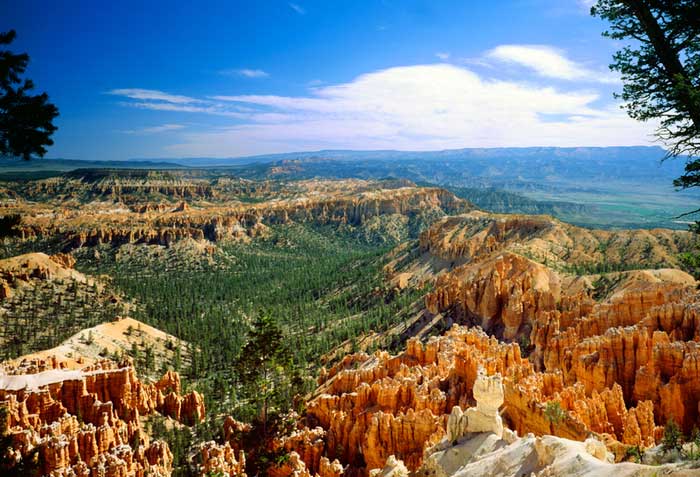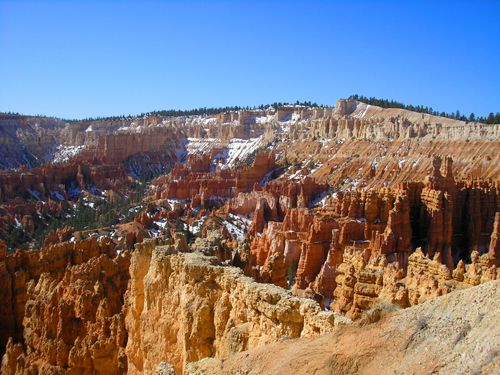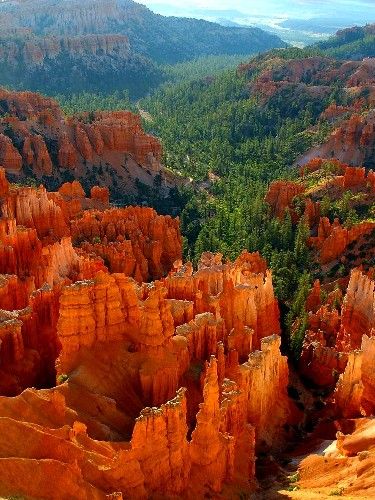By Felicity Walker
Bryce Canyon is not a canyon. It is the spectacular edge of the Paunsaugunt Plateau, where intricately carved towers and archways of stone shimmer in a dazzling array of colors under the bright sun.
The state of Utah in the United States is home to many beautiful National Parks, and Bryce Canyon National Park ranks as one of the most magnificent and awe-inspiring.
Fifteen million years ago, the earth in this region began to shift, forming a series of plateaus. The Paunsaugunt is an extensive plateau, with the Paria River gradually eroding the edge to form Bryce Canyon.
The rock in Bryce Canyon comprises layer after layer of sediment deposits, deposited millions of years ago when the area was at the bottom of a lake. The Paria River has exposed the layers, allowing a detailed lake history to be determined.
The park was established in 1924 and was named after Ebenezer Bryce, an early settler in the area. He emigrated from Scotland, married a local girl, and then moved southwards in stages, building sawmills as he went. In the mid-1870s, he reached the Paria River, where he and his family settled for several years. At this time, Bryce made his immortal comment about Bryce Canyon – he called it “one hell of a place to lose a cow.”
The area remained undiscovered by European tourists, the first guest houses only being constructed when the park was officially established. Luckily, this has led to Bryce Canyon being an area of largely unspoiled beauty and the enormous scientific value of the historic information trapped in its pinnacles and spires.
The canyon is not stagnant; the rim recedes by an average of about a foot every 50 years. Water plays the most vital role in shaping and eventually destroying the magnificent scenery in this ever-changing scene. Because the rock was laid down in layers, there is a variation in the hardness of the rock formed. When water runoff trickles across the rock, some areas erode rapidly, whereas others hold firm.
This variation in erosion speed causes the formation of pinnacles, or “hoodoos,” of stable rock. In some places, the water seeps through cracks and eats out holes beneath the surface. When the side rock erodes, an archway is left behind. Eventually, the arch collapses, leaving two more pillars to join the rest. The ever-changing vista of colors, spires, walls, and archways is spectacular at any season, and the park is open all year round.
In the warmer months, there are plenty of trails for the visitor to explore, ranging from leisurely strolls to challenging hikes. Some of the best trails are in the Bryce Amphitheatre, near the park’s entry.
Here, you can wander through the Queen’s Garden or gaze up at Queen Victoria, surveying the ‘flowers’ in her garden. Some of the most awe-inspiring lookouts in this area, including Sunset Point and Inspiration Point – are a must for any visitor. Walkers can also follow the Fairyland, Riggs Spring, and Under-the-Rim trails, which are longer but allow more opportunities to see the different elements of the park at close quarters.
Summer months can cause temperatures in the base of the canyon to soar, so it is essential to be prepared for the heat and carry plenty of water. In winter, the roads are opened between snowfalls, allowing a different perspective of the park. Snow-capped pinnacles stand out sharply against the background of white snow and dark green trees. The air is also cleaner, allowing visitors to see great distances. For the energetic, it is possible to cross-country ski in several areas in the park, and on some trails, it is possible to go snowshoeing instead of hiking.
If you want a slightly different view of the park, exploring it in a 1930 limousine is possible. Alternatively, you can rent a horse hourly to trek some better trails.
There is plenty of interest to explore in the park, apart from the marvelous scenery of the ‘silent city,’ as the hoodoos are sometimes called. The park also contains many plants and wildlife, including meadows and forests.
Ground squirrels abound near the viewing areas, and their antics are almost enough to distract the visitor’s eyes from the scenery. On quiet mornings and evenings, it is also possible to see deer, elk, and antelope grazing in the meadows.
Some bears and mountain lions also enter the park occasionally but are rarely seen by tourists.
Bryce Canyon is a hidden jewel, thoroughly deserving of being as well known as its southern neighbor, the Grand Canyon. Include it on your itinerary, and you definitely won’t be disappointed.
Like almost every other visitor, you may be completely overwhelmed by the fascinating and awe-inspiring beauty of Bryce Canyon.
Contact Information:
Bryce Canyon National Park
PO Box 170001
Bryce Canyon, Utah 84717-0001
435-834-5322
About The Author: Traveling to the national parks in the U.S. is one of the author’s favorite things to do. Copyright Felicity Walker 2005. Article provided by: Ezine Articles (dead link.) Compiled and edited by Kathy Alexander/Legends of America, updated January 2024.
Also See:
National Parks, Monuments & Historic Sites



